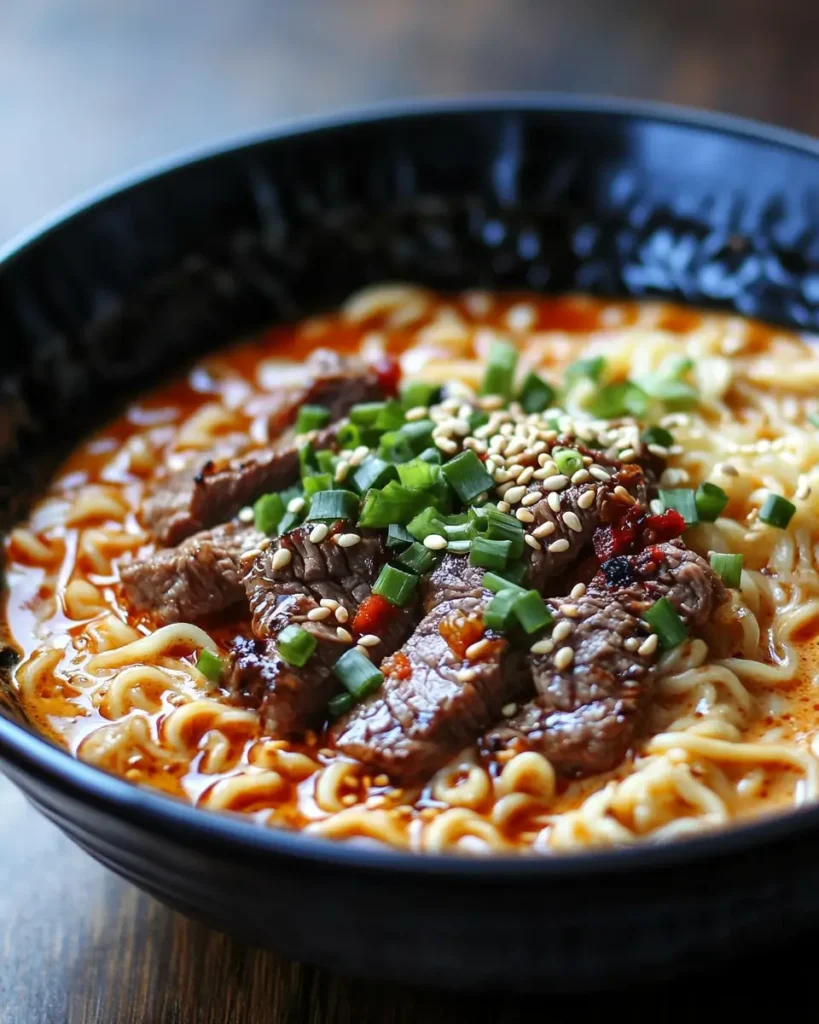1. Introduction
Table of Contents
Table of Contents
As the evening unfolds here in Ouarzazate, the craving for something bold and flavorful often strikes. Today, we’re bringing you a dish that perfectly fits that bill: Spicy Korean Ramen with Grilled Beef and Creamy Sauce. This recipe features tender slices of marinated beef grilled to perfection, combined with chewy ramen noodles in a fiery gochujang-based sauce enriched with creamy goodness. It’s a fusion of textures and tastes that’s both comforting and exciting.
This Korean ramen takes the instant noodle experience to a whole new level. The marinated beef adds a savory and slightly sweet element, while the gochujang provides a signature Korean spiciness. The creamy touch balances the heat beautifully, creating a well-rounded and deeply satisfying bowl. Adding a runny egg on top is optional but highly recommended for extra richness. If you enjoy dishes with a kick and a creamy finish, much like our Easy Chicken and Rice Bowls with Creamy Garlic Sauce (though with a different spice profile), you’re going to love this Spicy Korean Beef Ramen. Let’s get cooking!
2. Recipe Summary
- Cuisine: Korean-inspired, Fusion
- Difficulty level: Medium
- Total preparation and cooking time: 45 minutes
- Dietary classification: Not gluten-free (ramen noodles and soy sauce usually contain gluten).
3. Equipment and Utensils
- Medium bowl for marinating
- Large pot for cooking ramen
- Large skillet or wok
- Cutting board
- Sharp knife
- Measuring spoons
4. Serving Suggestions
- Plating: Serve hot in bowls. Arrange the noodles, beef, and sauce attractively. If using, place the egg gently on top. Garnish generously with sesame seeds and chopped chives.
- Side Dish Ideas: Kimchi, pickled radish, or other Korean banchan (side dishes).
- Complementary Side Dishes: A simple cucumber salad or some steamed dumplings would pair well.
- Wine or Beverage Pairings: A crisp lager or a slightly sweet rice wine (like Makgeolli). For non-alcoholic options, try a chilled barley tea or a sparkling water.
5. Nutritional Information
- Detailed Nutritional Breakdown (per serving, estimated):
- Calories: 650 kcal
- Carbohydrates: Approximately 60-65g
- Protein: Approximately 35-40g
- Fat: Approximately 30-35g
- Macronutrient Distribution: Roughly 40% Carbohydrates, 25% Protein, 35% Fat.
- Dietary Information: Not gluten-free. Contains dairy.
- Potential Health Benefits: Beef provides iron and protein. Gochujang contains probiotics.
6. Storage and Reheating
- Proper Storage Instructions: It’s best to eat this ramen fresh. However, if you have leftovers, store them in an airtight container in the refrigerator, keeping the noodles separate from the broth if possible to prevent them from becoming too soggy.
- Refrigeration Instructions: Keep refrigerated at or below 40°F (4°C).
- Freezing Recommendations: Freezing is not recommended as the texture of the noodles and the creamy sauce may change significantly upon thawing. The beef can be frozen separately.
- Reheating Methods:
- Stovetop: Reheat the sauce and beef in a skillet over medium heat. Separately, you can briefly reheat the noodles in boiling water or in the sauce.
- Microwave: Reheat portions in a microwave-safe bowl. Be mindful that the noodles might become a bit soft.
7. Expert Tips and Variations
- Tips from Professional Chefs: Marinating the beef for a longer time (up to a few hours) will deepen its flavor. Adjust the amount of gochujang and red chili to your spice preference.
- Common Mistakes to Avoid: Overcooking the beef, which can make it tough; overcooking the ramen noodles, which can make them mushy.
- Creative Recipe Variations:
- Protein: Substitute beef with thinly sliced pork, chicken, or even tofu for a vegetarian option.
- Vegetables: Add other vegetables like sliced mushrooms, spinach, bean sprouts, or scallions.
- Spice Level: Adjust the amount of gochujang and chili flakes. You can also add a dash of sriracha for extra heat.
- Creaminess: For a richer sauce, you can use half-and-half instead of heavy cream.
- Seasonal Adaptations: This hearty ramen is great year-round. You can adjust the vegetables based on what’s in season.
8. Ingredients Section
- 200g grilling beef, thinly sliced (approximately 7 oz)
- Quality and Sourcing Recommendations: Sirloin, ribeye, or any tender cut suitable for grilling. Slice thinly against the grain.
- 2 packets ramen noodles (the noodles only, discard seasoning packets or save for another use)
- Sourcing: Asian grocery stores or the international aisle of supermarkets.
- 1 onion, chopped
- Sourcing: Yellow or white onion.
- Preparation Notes: Roughly chop.
- 2 garlic cloves, minced
- Sourcing: Fresh garlic.
- Preparation Notes: Finely mince.
- 1 red chili, finely chopped (or less to taste)
- Sourcing: Produce section.
- Preparation Notes: Remove seeds for less heat if desired.
- 2 tablespoons soy sauce
- Sourcing: Asian grocery stores or supermarkets.
- 1 tablespoon gochujang (Korean chili paste)
- Sourcing: Korean grocery stores or the international aisle.
- 1 tablespoon honey
- 1 tablespoon sesame oil
- Sourcing: Asian grocery stores or supermarkets.
- 1/2 cup beef broth
- Quality and Sourcing Recommendations: Low sodium is recommended.
- 1/4 cup heavy cream
- Sourcing: Dairy aisle.
- 1 egg per serving (optional)
- Quality and Sourcing Recommendations: Fresh eggs.
- Preparation Notes: Can be fried, poached, or added directly to the hot ramen.
- Sesame seeds, for garnish
- Chopped chives (or scallions), for garnish
Metric Conversions (Approximate):
- 200g beef ≈ 7 oz
- 1 tablespoon ≈ 15 ml
- 1/2 cup ≈ 120 ml
- 1/4 cup ≈ 60 ml
9. Step-by-Step Instructions
- Marinate Beef: In a medium bowl, combine the thinly sliced beef, soy sauce, gochujang, and honey. Mix well to ensure the beef is coated. Let it marinate for at least 15 minutes.
- Cook Ramen: Cook the ramen noodles according to the package instructions. Drain and set aside.
- Sauté Aromatics: Heat the sesame oil in a large skillet or wok over medium-high heat. Add the chopped onion and minced garlic. Cook until softened, about 3-5 minutes.
- Cook Beef: Add the marinated beef and the finely chopped red chili to the skillet. Cook until the beef is cooked through and slightly browned.
- Add Broth and Cream: Pour in the beef broth and let it simmer for 5 minutes. Stir in the heavy cream and mix well until the sauce is creamy.
- Combine with Noodles: Add the cooked ramen noodles to the sauce and toss to coat them evenly.
- Add Egg (Optional): If desired, fry or poach an egg separately. Alternatively, you can crack an egg directly into the hot ramen in the skillet during the last minute of cooking and cover until the white is set and the yolk is still runny.
- Garnish and Serve: Ladle the ramen into bowls. Top with the cooked egg (if using), sesame seeds, and chopped chives. Serve immediately and enjoy!
Sweet tooth calling? Share this easy & delicious Spicy Korean Ramen with Grilled Beef and Creamy Sauce recipe with your friends on Facebook or save it to your Pinterest boards for a sunny day treat!

10. Frequently Asked Questions (FAQ)
What is Korean spicy ramen?
Korean spicy ramen refers to instant noodles from Korea that are known for their significant level of spiciness. A very popular example of this is the Buldak Ramen (also known as “fire noodles”) series by Samyang, which comes in various levels of heat and flavors. However, many other Korean ramen brands also offer spicy versions of their noodles.
What is Korean ramen made of?
Korean instant ramen typically consists of: * Noodles: Usually made from wheat flour, palm oil, and often includes starches and alkaline salts for a chewy texture. * Soup base powder: This packet contains the main flavorings, which usually include spices (like gochugaru – Korean chili powder), salt, MSG, and other flavor enhancers. * Flavor oil packet: Some ramen includes a packet of oil, often chili oil or sesame oil, to add richness and flavor. * Dried flakes: These can include dehydrated vegetables, seaweed, and sometimes small pieces of imitation meat or egg.
Can Muslims eat Buldak ramen?
Some varieties of Buldak ramen are halal-certified, while others are not. It’s crucial for Muslims to check for a halal certification logo (like from the Korea Muslim Federation – KMF) on the packaging. Samyang produces both halal and non-halal versions of the same flavors, sometimes in different facilities. If there is no halal logo, it’s best to avoid it to ensure it meets halal standards.
What is the most popular Korean ramen?
Determining the most popular can be subjective and may vary over time and by region. However, some consistently highly-rated and best-selling Korean instant ramen include: * Nongshim Shin Ramyun: A classic spicy beef-based ramen. * Ottogi Jin Ramen: Available in mild and spicy versions, it’s a top seller in Korea. * Samyang Buldak Ramen (Fire Noodles): Known for its intense spiciness and various flavors like Carbonara and Cheese, it has gained global popularity.

